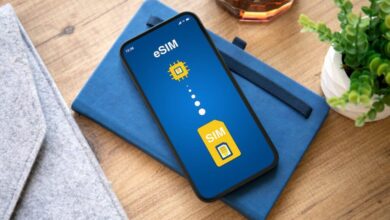How to Choose the Right Connectivity Options for International Travel

Imagine landing in a foreign country and suddenly losing all connection to the world. No maps, no translation apps, no way to contact your Airbnb host who’s supposed to meet you. Nightmare scenario, right? For today’s travelers, reliable international travel connectivity is no longer a luxury—it’s a necessity.
Whether you’re capturing Instagram-worthy moments, navigating unfamiliar streets, or just checking in with loved ones back home, staying connected enhances your travel experience while providing critical safety and convenience benefits. But with so many options available, from traditional roaming to cutting-edge technologies, choosing the right connectivity solution can feel overwhelming.
Let’s explore how to stay connected abroad without emptying your wallet.
eSIM Technology: The Future of International Connectivity
eSIM technology is revolutionizing how travelers stay connected abroad, offering unprecedented flexibility and convenience.
What Makes eSIM Technology Revolutionary for Travelers
Unlike physical SIM cards, eSIMs are built into your device and can be programmed remotely. This means you can purchase and activate a local data plan before you even leave home—no more hunting for SIM vendors at foreign airports or struggling with language barriers.
Many Italian students come to believe that struggling in calculus means they’re simply “not good at math.” But the best online tutors focus on building a growth mindset—the idea that skills improve with practice, not just talent. This mindset shift is powerful. Students start to approach problems with curiosity instead of fear, knowing they have the tools and support to improve.
For Italy specifically, finding the best esim italy options can significantly enhance your European travel experience. Italian eSIMs typically offer excellent coverage through partnerships with major local networks like TIM, Vodafone, and WindTre, ensuring reliable connectivity throughout the country, from Rome’s bustling streets to the serene countryside of Tuscany.
Top Global eSIM Providers Compared
Several providers compete in the global eSIM market, each with different strengths:
- Some specialize in regional coverage, offering optimized plans for specific destinations
- Others focus on global coverage, ideal for multi-country itineraries
- Pricing models vary from data-based packages to unlimited plans with speed caps
When evaluating providers, consider not just the price per gigabyte but also network quality, customer service availability, and activation process simplicity.
While eSIM technology offers incredible convenience, traditional physical SIM cards remain a viable option for many travelers.
Local SIM Cards: The Budget-Friendly Traditional Option
For travelers on a budget, local SIM cards remain one of the most cost-effective mobile data solutions for travel.
Navigating the Local SIM Card Market
In most countries, you can purchase a local SIM card at airports, convenience stores, or telecom shops. The process typically requires:
- An unlocked phone (check with your carrier before departure)
- Your passport for registration (required in many countries)
- Basic knowledge of plan options or assistance from store staff
The advantage of local SIMs is that you’re getting truly local pricing rather than tourist-oriented packages, often resulting in more data for less money.
Maximizing Value with Local Data Plans
To get the best deal on local SIMs:
- Research common carriers in your destination before arriving
- Ask locals or hotel staff for recommendations on reliable providers
- Consider your length of stay—some plans offer better weekly or monthly rates
- Check if the provider offers tourist-specific packages, which sometimes include benefits like local attraction discounts
Local SIMs work well for single-country visits, but become cumbersome if you’re traveling to multiple countries. This is where dedicated travel WiFi options come into play.
Portable WiFi Hotspots: Connectivity for Multiple Devices
For travelers needing to connect multiple devices or traveling with family, portable WiFi hotspots offer a convenient solution.
Rental vs. Purchase Considerations
You can either purchase a hotspot device or rent one specifically for your trip. Rental services often provide better value for shorter trips, while purchasing makes sense for frequent travelers.
Companies like Skyroam, TEP Wireless, and Hippocketwifi specialize in travel hotspot rentals with various coverage options and data plans. Some will deliver the device to your home before departure and provide a return envelope for easy shipping when your trip ends.
Battery Life and Performance Factors
When selecting a portable hotspot, consider:
- Battery duration (ideally 8+ hours of active use)
- The number of devices it can connect to simultaneously
- Network compatibility in your destination countries
- Data allowances and throttling policies
Portable hotspots provide great flexibility but add another device to charge and carry. For more minimalist travelers, leveraging free WiFi might be preferable.
Free WiFi Strategies: Supplementing Your Connectivity Plan
While having your data connection is ideal, supplementing with free WiFi can help extend your data budget significantly.
Mapping Out Reliable Free WiFi Locations
Before your trip, research WiFi availability at your destination:
- Most international airports, major hotel chains, and global coffee shop brands offer free WiFi
- Many museums, libraries, and public spaces in Europe and Asia provide free connectivity
- Apps like WiFi Map can help locate verified networks with password information
Remember that public WiFi networks pose security risks. Always use a VPN when connecting to public networks, especially for sensitive activities like banking or email.
With a combination of your data solution and strategic free WiFi usage, you can optimize both connectivity and costs during your travels, making international adventures smoother and more enjoyable.
Creating a Custom Connectivity Plan for Your Next Trip
With all these options in mind, it’s time to build a personalized connectivity strategy for your upcoming journey.
International Travel Connectivity Decision Framework
Consider these factors when making your decision:
1. Trip duration (short trips might favor carrier add-ons, longer ones local SIMs or eSIMs)
2. Number of countries (multi-country trips benefit from global eSIMs or portable hotspots)
3. Data needs (occasional map users have different needs than remote workers)
4. Device compatibility (older phones may not support eSIM technology)
5. Budget priorities (balancing convenience versus absolute savings)
The ideal approach often combines primary and backup connectivity methods. For example, an eSIM for your primary data needs, with knowledge of free WiFi locations as a backup.
Pre-Departure Connectivity Checklist
Before leaving home:
- Ensure your phone is unlocked if planning to use local SIMs
- Download essential apps and offline maps
- Set up and test your chosen connectivity solution, if possible
- Inform your home carrier of your travel dates to avoid service interruptions
- Back up important contact information and travel documents
With proper planning, you’ll enjoy seamless connectivity throughout your journey, enhancing both the safety and enjoyment of your international adventure.
Connectivity Considerations for Global Travelers
When exploring the world, connectivity needs vary based on destination and purpose. Using the right tools makes all the difference.
Regional Connectivity Insights
| Region | Best Connectivity Option | Approximate Cost | Network Quality | Notable Considerations |
| Europe | eSIM / Local SIM | $10-30/week | Excellent | EU regulations allow for seamless roaming |
| Asia | Local SIM | $5-20/week | Good to Excellent | Inexpensive data packages in most countries |
| North America | Carrier Travel Plans | $10/day | Excellent | Expensive but convenient |
| Middle East | eSIM | $15-40/week | Good | Varying restrictions on VoIP services |
| Africa | Portable WiFi Hotspot | $8-15/day | Variable | Reliability concerns in remote areas |
This comparison highlights how dramatically connectivity options can vary by region, reinforcing the importance of destination-specific research before traveling.
FAQs
1. What’s the most cost-effective way to stay connected during a two-week European tour?
For multi-country European travel, an eSIM with EU-wide coverage typically offers the best combination of convenience and value, eliminating the need for multiple local SIMs while providing reliable service across borders.
2. How can I ensure I have enough data for navigation without overspending?
Download offline maps before departure, use free WiFi for large app updates, and consider a data monitoring app to track usage patterns. Most travelers find 1-2GB sufficient for basic navigation and communication.
3. Will my US smartphone work internationally without modifications?
Most modern US smartphones will work internationally, but they must be network unlocked to use local SIMs. Check with your carrier about unlocking policies and international compatibility before traveling.
Taking the Connected Journey Forward
Choosing the right international connectivity solution doesn’t have to be complicated. By assessing your specific needs, researching destination-specific options, and preparing before departure, you can ensure you stay connected without unnecessary expense or stress.
Remember that connectivity technology continues to evolve rapidly, with new options emerging regularly. The best approach is to stay informed about the latest mobile data for travel solutions and to adapt your strategy as new technologies and services become available.




